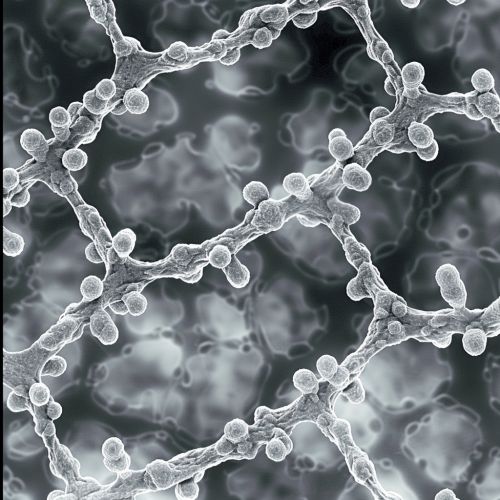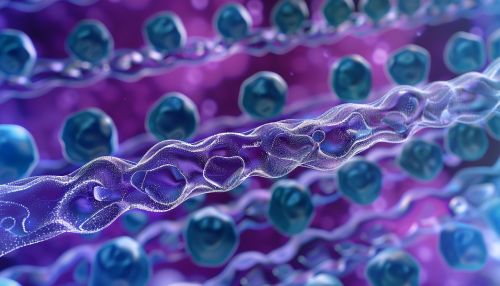Phospholipid bilayer: Difference between revisions
(Created page with "== Structure and Composition of the Phospholipid Bilayer == The phospholipid bilayer is a fundamental component of all biological membranes, providing the structural basis for cell membranes. This bilayer is composed of two layers of phospholipids, which are amphipathic molecules containing both hydrophilic (water-attracting) and hydrophobic (water-repelling) regions. The unique arrangement of these molecules allows the bilayer to form a semi-permeable membrane, cru...") |
No edit summary |
||
| Line 3: | Line 3: | ||
The [[phospholipid bilayer]] is a fundamental component of all biological membranes, providing the structural basis for cell membranes. This bilayer is composed of two layers of phospholipids, which are amphipathic molecules containing both hydrophilic (water-attracting) and hydrophobic (water-repelling) regions. The unique arrangement of these molecules allows the bilayer to form a semi-permeable membrane, crucial for maintaining cellular integrity and function. | The [[phospholipid bilayer]] is a fundamental component of all biological membranes, providing the structural basis for cell membranes. This bilayer is composed of two layers of phospholipids, which are amphipathic molecules containing both hydrophilic (water-attracting) and hydrophobic (water-repelling) regions. The unique arrangement of these molecules allows the bilayer to form a semi-permeable membrane, crucial for maintaining cellular integrity and function. | ||
[[Image:Detail-91281.jpg|thumb|center|Microscopic view of a phospholipid bilayer, showing the arrangement of phospholipids with hydrophilic heads facing outward and hydrophobic tails facing inward.|class=only_on_mobile]] | |||
[[Image:Detail-91282.jpg|thumb|center|Microscopic view of a phospholipid bilayer, showing the arrangement of phospholipids with hydrophilic heads facing outward and hydrophobic tails facing inward.|class=only_on_desktop]] | |||
=== Phospholipid Structure === | === Phospholipid Structure === | ||
Latest revision as of 00:01, 22 June 2024
Structure and Composition of the Phospholipid Bilayer
The phospholipid bilayer is a fundamental component of all biological membranes, providing the structural basis for cell membranes. This bilayer is composed of two layers of phospholipids, which are amphipathic molecules containing both hydrophilic (water-attracting) and hydrophobic (water-repelling) regions. The unique arrangement of these molecules allows the bilayer to form a semi-permeable membrane, crucial for maintaining cellular integrity and function.


Phospholipid Structure
Phospholipids consist of a glycerol backbone, two fatty acid tails, and a phosphate group attached to a polar head. The fatty acid tails are hydrophobic, while the phosphate head is hydrophilic. This dual nature enables the formation of the bilayer, where the hydrophobic tails face inward, shielded from water, and the hydrophilic heads face outward towards the aqueous environment.
Formation and Stability
The formation of the phospholipid bilayer is driven by hydrophobic interactions. When phospholipids are placed in an aqueous environment, they spontaneously arrange themselves into a bilayer to minimize the exposure of hydrophobic tails to water. This self-assembly is a key feature of biological membranes, contributing to their stability and fluidity.
Fluid Mosaic Model
The fluid mosaic model describes the dynamic nature of the phospholipid bilayer. According to this model, the bilayer is fluid, with phospholipids and proteins moving laterally within the layer. This fluidity is essential for various cellular processes, including membrane transport, cell signaling, and membrane fusion.
Membrane Proteins
Embedded within the phospholipid bilayer are various membrane proteins, which play critical roles in cellular function. These proteins can be classified into integral and peripheral proteins. Integral proteins span the bilayer and are involved in transport and signaling, while peripheral proteins are attached to the surface and assist in maintaining the cell's shape and structure.
Functions of the Phospholipid Bilayer
The phospholipid bilayer serves multiple functions essential for cell viability and function.
Selective Permeability
The bilayer acts as a selective barrier, allowing certain molecules to pass while restricting others. Small nonpolar molecules, such as oxygen and carbon dioxide, diffuse easily through the bilayer, whereas ions and large polar molecules require specific transport proteins.
Compartmentalization
The bilayer provides compartmentalization within cells, creating distinct environments for different biochemical processes. This compartmentalization is crucial for the organization and efficiency of cellular functions.
Signal Transduction
Membrane proteins within the bilayer are involved in signal transduction, transmitting signals from the extracellular environment to the cell's interior. This process is vital for cellular responses to external stimuli.
Cell-Cell Interaction
The phospholipid bilayer facilitates cell-cell interactions through membrane proteins and glycoproteins. These interactions are essential for tissue formation, immune responses, and cellular communication.
Dynamics and Regulation
The phospholipid bilayer is not static; its composition and properties are dynamically regulated.
Lipid Rafts
Lipid rafts are microdomains within the bilayer, enriched in cholesterol and sphingolipids. These rafts serve as platforms for signaling molecules and play a role in membrane organization and trafficking.
Membrane Fluidity
Membrane fluidity is influenced by factors such as temperature, fatty acid composition, and cholesterol content. The presence of unsaturated fatty acids increases fluidity, while cholesterol modulates fluidity and stability.
Endocytosis and Exocytosis
The bilayer is involved in endocytosis and exocytosis, processes that allow the cell to intake and release materials. These processes are essential for nutrient uptake, waste removal, and cellular communication.
Pathophysiological Implications
Alterations in the phospholipid bilayer can lead to various diseases and disorders.
Membrane Disorders
Defects in membrane proteins or lipid composition can result in membrane disorders, affecting cellular function and leading to diseases such as cystic fibrosis and muscular dystrophy.
Lipid Metabolism Disorders
Abnormalities in lipid metabolism can impact the bilayer's composition, contributing to conditions like atherosclerosis and metabolic syndromes.
Research and Applications
The study of the phospholipid bilayer has significant implications for biomedical research and applications.
Drug Delivery
Understanding the bilayer's properties is crucial for developing drug delivery systems, such as liposomes and nanoparticles, which can traverse the cell membrane to deliver therapeutic agents.
Synthetic Biology
In synthetic biology, researchers aim to design artificial membranes and cells, leveraging knowledge of the phospholipid bilayer to create functional biological systems.
